

The Magazine of The University of Montana
Around the Oval
Maintaining Main Hall
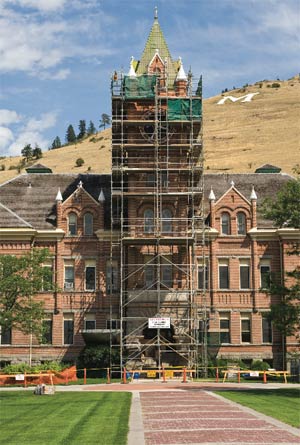
Photo by Todd Goodrich
Apart from the percussion of the marching band, the boom of the game- day cannon, and the roar from washington- Grizzly Stadium, alumni on campus for Homecoming will find a familiar sound missing: the bells of main Hall.
Renovations on one of the most recognizable and beloved buildings in Western Montana began in July and are expected to last through football season.
Restoration efforts will focus on the clock tower and roof in a $1.4 million state- and University-funded project. Construction crews will replace the roof, make masonry repairs, and build a web of iron structural supports inside the tower for seismic reinforcement.
The project aims to make crucial changes while maintaining the legendary look of the University’s cornerstone. Original construction on Main Hall, designed by celebrated Missoula architect A.J. Gibson, began upon the founding of UM in 1893. UM architect and project manager Jerry Ballas says that this is the first major reconstruction project on the building’s exterior—an effort in the works for the past few years. President George Dennison notes the importance of taking steps now to preserve the premier UM building.
“Everyone knows The University of Montana by the icon of ‘Main Hall,’ the popular reference to ‘University Hall,’” says Dennison. “We must act to protect the integrity of this historic treasure, the centerpiece of The University of Montana Historic District.”
To do so, UM will replace two layers of wood shingles— the most recent dating from the 1970s—with shingles that look like weathered wood shakes but are made from recycled rubber. The high-tech shingles are similar to those used for renovations at the Daly Mansion in Hamilton and on Old Main at Montana State University in Bozeman.
Masonry crews plan to tackle brick deterioration on the clock tower and refinish parts of the granite entryway. New structural supports will brace the interior of the tower from its top to the second floor.
— Ashley Zuelke
Two New Deans Take Helms
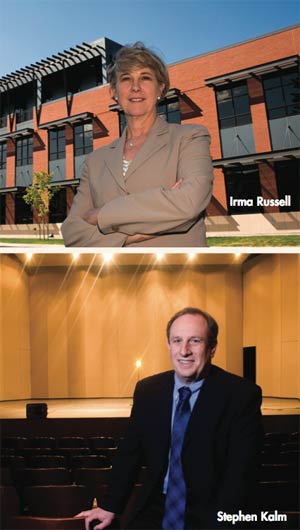
UM ushered in the new academic year with two new deans — one in the School of Law and one in the College of Visual and Performing Arts (formerly the School of Fine Arts).
Irma Russell, a legal scholar and national leader in environmental and energy law, became the law school’s first woman dean on July 1. She replaces E. Edwin Eck, who chose to step down and return to the law faculty after fourteen years as dean. A search committee selected Russell from five candidates who came to campus last spring.
“Professor Russell rates ‘outstanding’ in every category,” says UM Provost Royce Engstrom. “She is a well-regarded scholar in the field of environmental and energy law, a top-notch legal educator, and a respected leader capable of building upon the law school’s strengths.”
Russell came to UM from the University of Tulsa College of Law, where she was a professor and director of the National Energy-Environment Law and Policy Institute. She chairs committees in two American Bar Association sections: Environment, Energy, and Resources, and
Legal Education and Admission to the Bar.
Russell is a graduate of the University of Kansas, where she earned bachelor’s degrees in liberal arts and education, a master’s in English literature, and her law degree.
Stephen Kalm became dean of visual and performing arts May 1 after serving as interim dean since the retirement of Shirley Howell a year earlier. He was selected from a national search that brought three strong candidates to campus.
Engstrom says Kalm “has been an exceptional faculty member, and did excellent work while serving as interim dean. We are entering an especially exciting time for the arts, with the new status as the College of Visual and Performing Arts and new leadership in the dean’s office.”
Kalm joined the UM faculty in 1994 and chaired the music department from 2002 to 2008. He is an award- winning vocalist, opera singer, and music professor—performing in local, national, and international venues.
Kalm holds three degrees in vocal performance: a bachelor’s from the San Francisco Conservatory of Music, a master’s from Queens College, and a doctorate from the City University of New York.
The President's Corner
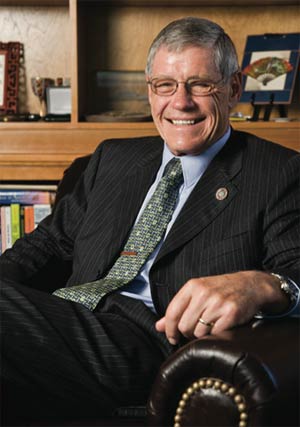
This issue of the Montanan casts in bold relief the incredible diversity of talent of the people who constitute The University of Montana community, even if only for brief periods, while also emphasizing what they have in common. From the Griz athletes who have claimed their places in the NFL to the faculty researchers by and large responsible for the transformation of a liberal arts campus into a research university, success in realizing their dreams derived from their competitiveness whatever the odds. That same determination to achieve brought Jeff Ament from Big Sandy to Missoula to Seattle to the world and back again. We celebrate these attributes, in the full realization that the success of those attracted to the campus inspires others to follow. And why not? Every university, as the truism has it, consists of its students, staff, faculty, and alumni. In this regard, the stature of The University of Montana has risen with the accomplishments and achievements of the people who comprise it.
This tenacious striving for success characterizes the campus community and the University itself. We now rise to the greatest challenge of our time—returning the United States to world leadership in the educational attainment of its citizenry after having fallen within two decades to the second tier and being in danger
of slipping to the third. We shall need the resourcefulness and competitiveness that explains the trajectory of the University as a graduate research university and the remarkable successes of our students and faculty. And, make no mistake, we must succeed, for failure will assure a future we Americans shall surely not select. Consider that this country now stands as the only industrialized country of the world with a better educated older generation than the younger generation. In the human capital economy of today’s global society, we simply cannot compete with such a disadvantage.
We of The University of Montana intend to do our part to assure success in the national effort announced by President Barack Obama and endorsed by all national and educational leaders across the country. Doing so will require hard work and great concentration. We will begin by making certain that we use our available resources to maximum effectiveness in order to justify the investment the country must make in order to achieve the goal by the early part of the third decade of the twenty-first century. The commitment to public higher education explains how the United States attained world educational leadership during an earlier era, and that same commitment combined with the will to excel will return the nation to that status.
George M. Dennison, ’62, ’63
President and Professor of History
Notable and Quotable
Montana college sports fans can breathe easier. The NCAA Executive Committee has adopted a policy relating to sports wagering and the conduct of NCAA championships that will allow future college play-off games to be held in Montana. University of Montana President George Dennison says, “We appreciate the deliberate thoughtfulness of the NCAA Executive Committee in developing and adopting a policy that maintains the integrity of sporting events, while at the same time recognizing the gaming situation in the state of Montana.” The new policy outlines that no NCAA championship may be conducted in a state that allows gambling based upon single-game betting in any NCAA championship sport. The committee defined single- game betting as wagering that involves either a money line or point-spread wager. Montana allows sports pools/pull tabs, and the state lottery runs a fantasy sports game for professional sports. These activities do not qualify as single-game betting under the policy.
UM signed a memorandum of understanding with the Dubai-based American University in the Emirates, paving the way for future collaboration, including student and faculty exchanges. AUE administrators contacted UM with the hope of forging a partnership, says Mehrdad Kia, associate provost for UM’s International Programs. He says AUE has particular interest in collaborating with UM’s School of Business Administration and College of Education and Human Sciences. UM, for its part, will be able to strengthen its programs in Middle Eastern studies and Arabic—fields of study that are seeing increased student interest, Kia says.
Bill Jones ’54, J.D. ’59, featured in the last issue of the Montanan for receiving the Montana Alumni Award at Charter Day 2009, was the subject of a profile in the July 2009 Mountain States edition of Super Lawyers magazine. The article, titled “An Organized Mind,” highlighted Jones’ career, as well as his knack for brevity in the courtroom. “... Even though a closing argument is short, if it appeals to tired jurors, then it’s the most meaningful thing,” Jones says in the pages of the magazine. This summer he celebrated fifty years as a trial lawyer at Missoula’s Garlington, Lohn & Robinson.
Three Alums Receive 2009 Distinguished Alumni Awards
Three exceptional UM graduates have been selected to receive the University's 2009 Distinguished Alumni Award.
They are Leon Billings '59, president of Billings LLC, a consulting firm that designs public policy strategies on issues before Congress and advises clients on political matters and a broad range of environmental, energy, health, and safety legislation; William Veazey ’70, MBA ’75, will receive the award posthumously. When he died in May 2008, Veazey was senior vice president, CFO, and
board member of Cargill Inc., a Minneapolis- based global provider of food, agricultural, and risk management products and services; and James Wylder ’51, who retired in 1986 as president and CEO of Great Falls Coca-Cola Bottling Company.
Billings, a Montana native who now lives in Bethany Beach, Del., has a lengthy history of public service at the local, state, and national level. He served twelve years in the Maryland House of Delegates and drafted federal environmental legislation that included the landmark Clean Air Act of 1970, the Clean Water Act of 1972, and their 1977 amendments. Billings served as executive assistant to Secretary of State Edmund Muskie and has held numerous leadership roles in the Democratic Party. He is nationally recognized as an authority on environmental issues and is dedicated to the preservation of the natural environment.
While at UM, Veazey, a Butte native and graduate of Missoula’s Hellgate High School, was honored with the Legion of Valor Bronze Cross for Achievment for exemplary service in the Army ROTC program and was a Distinguished Military Graduate. He began his career as an accountant in Minneapolis and with financial management jobs in the Cargill Corn Milling Division in the United States and Europe. In 1989 he became CFO of Cargill Europe, based in London. Veazey returned to Minneapolis in 1992 and was elected to the company’s top financial post in
2005 and to the board of directors in 2007. Throughout his career, he served as mentor to many young employees in the worldwide Cargill network.
In twenty-five years under Wylder’s management, Great Falls Coca-Cola Bottling Company’s sales increased from
$250,000 to $16 million, and case sales increased from 175,000 to 3 million. His territory included counties from Malta to Libby, Glacier Park to Cascade, and Flathead Valley to the Bitterroot. After Wylder’s acquisition of four adjacent bottling operations, his Coca-Cola franchise territory was the largest in Montana. Wylder retired from Coca-Cola in 1986 and began a second career in photography. He has demonstrated exceptional commitment to the Great Falls community through his volunteer work and advocacy for a variety of area organizations. He also has been an active supporter of UM, and his daughter says he “probably hasn’t missed a Grizzly football game in more than twenty years.”
WHERE’S YOUR GRIZ BEEN?
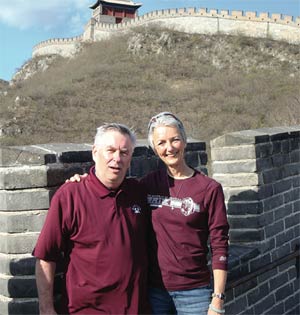
BOB AND KIMBERLEE EVANKO NYSTUEN ’76 proudly wear their Griz shirts during a trip to The Great Wall of China during May 2009. “We traveled with a group of one hundred folks from the greater Flathead Valley and visited Beijing, Suzhou, Hangzhou, and Shanghai,” Kimberlee writes. “We were proud to show our Montana Grizzly allegiance from China!”
Congratulations, Bob and Kimberlee. You’ve won a $50 gift card for use at The Bookstore at UM.
Do you have a photo of yourself wearing your Griz gear in an amazing place or while on an incredible adventure? If so, send it along with a brief description to: themontanan@umontana.edu. Winners will see their winning photo published in the Montanan and will receive a $50 gift card to The Bookstore at UM. To be considered, photos must be in focus with the UM or Griz logo clearly visible.
NEW BOOK SHARES HISTORY OF GRIZZLY FOOTBALL
Montana Grizzlies fans now can relish the football program’s storied past with a new book from Whitman Publishing.
The University of Montana Football Vault: The History of the Grizzlies tells the story of the team from its inception in 1897 through 2008, when the Griz made it to the national championship finals in Chattanooga, Tenn. Whitman Publishing has chronicled dozens of the most celebrated collegiate football and basketball programs in the nation with its College Vault series, but The History of the Grizzlies marks the first time it has featured a school from the Big Sky Conference.
Longtime Grizzly announcer Mick Holien recounts the history of Griz football alongside historical photographs, old newspaper clippings, game programs, and buttons. The book also features a foreword by Don Read and an afterword by Bobby Hauck.
In March, UM asked fans to bring their original Griz memorabilia to the Adams Center, where Whitman representatives scanned and photographed the items for inclusion in the book. Dozens of supporters answered the call, including a handful of teammates who played for the Griz in the 1940s and showed up to share their collectables. Others mailed in game programs, old tickets, and previously unpublished photographs. One Griz fan brought in his stepfather’s letter blanket. Additional material was mined from UM’s athletic department and University archives. The result is a “scrapbook-style” book which weighs nearly five pounds and features replica memorabilia that readers can remove from pockets on the pages.
The University of Montana Football Vault: The History of the Grizzlies, which has a suggested retail price of $49.95, will hit stores in September.
Confessions Chosen As First-Year Book
“WE ARE EACH THE LOVE OF someone’s life,” begins the novel selected as UM’s First-Year Reading Experience for incoming freshmen this fall.
New students are pondering that opening statement together this semester as they read and discuss The Confessions of Max Tivoli. The novel, written by UM graduate Andrew Sean Greer ’96, is a haunting, magical tale of reverse aging, love, and loss that rocketed to the top of best-seller lists after its 2004 release. The novel received numerous awards and was lauded by critics, who called it “enchanting” (John Updike in The New Yorker), “dazzling” (The New York Times), and “a rich and mesmerizing fable” (People).
UM’s First-Year Reading Experience unites new students on their shared journey through a chosen book with opportunities for discussion, a freshman writing contest, and a campus visit by the author.
Greer earned a master of fine arts degree from UM’s Creative Writing Program. He will return to campus October 21 to present a seminar and lecture for the first-year reading experience program. The events begin at 2:10 P.M. and 7:30 P.M., respectively, in the University Theatre, and are open to the public.
Written in an intimate first-person voice, Confessions tells the heartbreaking story of Max, who was born in turn-of- the-twentieth-century San Francisco with the mind of a newborn but the physical appearance of a seventy-year-old man. He is further cursed with knowing the year of his death: 1941.
As Max grows simultaneously older and younger, he struggles to live by his mother’s well-intended but deceitful rule: “Be what they think you are.” He falls in love with a neighbor girl, Alice, and because she doesn’t recognize him in subsequent encounters, he gets three opportunities over the course of his lifetime to try to win her heart.
Meet Grizwald,
The University of Montana’s cartoon bear. In the last issue of the Montanan, we asked readers to submit captions interpreting Grizwald’s actions in a funny way. This issue’s winning caption was sent in by CHARLES KING ’49. Congratulations, Charles, you’ve won a Griz stadium blanket.
Stay tuned! In the winter issue of the Montanan, a new cartoon featuring Grizwald will need a caption. You could be the next winner!
FACETIME: Sherry Jones ’06
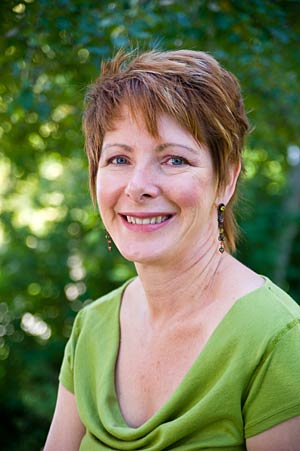
Sherry Jones
When Random House agreed last year to publish Sherry Jones’ honors thesis—a fictional account of the Prophet Muhammad’s favorite wife, Aisha—her spirits soared. But the publisher reneged on The Jewel of Medina after a professor of Islamic history at The University of Texas claimed in 2008 that the book could incite violence by radical Muslims. U.S.-based Beaufort Books picked up the novel and released it last October. Jones’ book remains unavailable, however, in the United Kingdom, where her publisher was attacked by arsonists last fall. The book’s sequel, The Sword of Medina, will hit store shelves this October.
What’s your typical day like?
My typical day consists of either feeling exhilarated because I’m getting to do something I really love, or feeling cranky because I didn’t get time to do the thing I really loved that day.
People ask if you fear for your well- being, but you say you’re more afraid that the word about your books won’t get out there? Why?
That’s right. I’m very concerned for the future of free speech in the Western world. I grew up in the Cold War and learned all about the evils of totalitarian government. And the one that resonated in me the most was not being able to speak freely.
What’s your perspective on self- censorship?
We should strive to be sensitive to other people’s feelings. That’s the golden rule. But if we lose our ability to criticize, civilization doesn’t progress. We need to be able to question, to discuss, to disagree, to dissent.
At what point do you think that writing ideas like those in The Jewel of Medina will be mainstreamed? Will they?
Every time a project is challenged and goes forth anyway, it makes it less likely that similar projects will be challenged. When people read about The Jewel of Medina, the self-censorship by Random House, and the arson attacks in Great Britain—it makes the entire Muslim community look bad, even though most Muslims are peace-loving, God-loving people. I think that moderate Muslims are speaking out more and more, and extremists are finding that protesting a book, a play, or a work of art doesn’t resonate the way it used to.
How difficult was it to blend a Western point of view with a Middle-Eastern subject?
One of the main challenges was getting the language down, and to do that I studied Arabic two years at the University. And, it’s hard to know how anyone thought back in the seventh century, no matter what culture.
What was your primary drive in writing your novels?
My impetus for research was having learned after September 11 of the way women were oppressed under the Taliban regime in Afghanistan. I wanted to find out if Islam was a religion that was oppressive to women or not, and why. I found that it’s not Islamic to be oppressive, so I wanted to share that.
What about you makes you want to tell stories about notable women?
I’m just so passionate about women and women’s equality. Maybe it’s because when I was a kid, I noticed that whenever I talked, my father would often interrupt me, as if I hadn’t been speaking. Maybe I’m still trying to be heard.
How did your education at UM help you in your career?
I wanted to write novels, but I never knew what I wanted to write until I read about Aisha and Muhammad’s other wives. The creative writing workshop . . . gave me a lot of confidence in my ability to write fiction. It improved my writing in every way. My years at The University of Montana, I wish I could go back and do them again.
Through writing The Jewel of Medina and weathering its criticism, what was your biggest trial?
The biggest challenge for me was finding the strength within myself to exhibit courage. I read somewhere once that we are born with all of the tools we need to survive in the world, but I didn’t believe it until this controversy came along and I had to endure so much hatred, hostility, and criticism—not only from offended Muslims but also from Islamophobes.
You went from wanting to be a writer, to thinking it might be better to get an engineering degree, and finally being able to pursue what you really want to do. Do you have advice for people on following their dreams?
Never stop believing in yourself. You’ve nothing to lose by trying and everything to gain by persevering and believing in yourself. I grew up in small towns, on Air Force bases; my parents didn’t have any money. Nobody in my family had gone to college. If I can be a published author, anyone can fulfill their dream, too.
– Interview by Ashley ZuelkeWEB EXCLUSIVE: Facetime: Sherry Jones (Cont.)
How do you balance between how much actual fact is in the book versus how much drama or fiction?
In my first draft of The Jewel of Medina I tried to be completely faithful to the history, which is all in the oral tradition. I would say my book is 95 percent historically accurate. But where there are gaps, I tried to provide an explanation. Where we don’t know why certain things happened, I tried to provide a motive, based on my understanding of the characters, of the culture, and of the history. I wrote an author’s note at the beginning of the book and a Q&A at the end of the book with full disclosure. In a way, I wonder if that was a good idea because it gives fuel to my critics. I’m glad to say the criticism has been mostly over semantics.
You’re an avid social networker. Does social networking make you feel more connected beyond Spokane (Wash.), then?
It does, actually. It also helps me keep in touch with what’s going on with the book. Last August, when the controversy first came out about The Jewel of Medina, I had a Google alert on my book. About a month ago, I canceled the alerts, not because I wasn’t getting them, but because so much of the online discussion around my book is stress-inducing.
Do you expect controversy with The Sword of Medina?
No. The Sword of Medina has been published in Germany and Serbia, and the reviews there have been really good so far. [The Sword] shows the Shiite and Sunni point of view on Islamic history, alternating throughout the book, which provides a complex picture. But I didn’t know what to expect with The Jewel of Medina, either. The Jewel of Medina would not have had that level of controversy if no one had ever called it pornographic. What [Denise Spellberg, an associate professor of Islamic history at the University of Texas at Austin] said [to Random House] . . . incited unjustified anger in the Islamic community toward my book.
So where do you stand on religion now, having grown up practicing Christianity?
I reject organized religion. However, I do believe that if there is a God, that God is simply the force of love. The impulse of love, the act of love, I think it comes from a godly place. I can think of no other explanation for compassion and for the feeling of good in the world. Love is a verb. Writing The Jewel of Medina, for me, was a spiritual awakening. I felt a real connection to Aisha.
What is your current project?
Right now I’m reading about these queens in the 13th century, and once again, it’s all about the kings, their husbands, so I’m extrapolating based on what role they played in this or that and what kind of person they might have been. Recently, when my mind has an idle moment, it tends to turn to these women, and I start imagining scenes in which they might appear in my book. It’s exciting, it’s so much fun . . . it all happened when I started to write The Jewel of Medina, too.

 Email Article
Email Article 